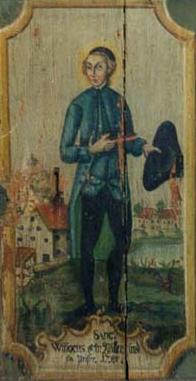St. Winnoc

Saint Winnoc of Flanders. Old door sign from the Pforzner monastery mill. Today on loan at the Kaufbeurer local history museum.
Abbot or Prior or Wormhoult, died 716 or 717. Three lives of this saint are extant: the best of these, the first life, was written by a monk of St. Bertin in the middle of the ninth century, or perhaps a century earlier. St. Winnoc is generally called a Breton, but the Bollandist de Smedt shows that he was more probably of British origin. He came to Flanders, to the Monastery of St. Sithiu, then ruled by St. Bertin, with three companions, and was soon afterwards sent to found at Wormhoult, a dependent cell or priory (not an abbey, as it is generally called). It is not known what rule, Columbanian or Benedictine, was followed at this time in the two monasteries. When enfeebled by old age, St. Winnoc is said to have received supernatural assistance in the task of grinding corn for his brethren and the poor; a monk who, out of curiosity, came to see how the old man did so much work, was stuck blind, but healed by the saint’s intercession. Many other miracles followed his death, which occurred 6 November, 716 or 717. We only know the year from fourteenth-century tradition. The popularity of St. Winnoc’s cultus is attested by the frequent insertion of his name in liturgical documents and the numerous translations of his remains, which have been preserved at Bergues-St-Winnoc to the present day. His feast is kept on 6 November, that of his translation on 18 September; a third, the Exaltation of St. Winnoc, was formerly kept on 20 February.
Acta SS., II Nov., 253; Acta SS. O.S.B., III, i; 291; Acta SS. Belgii, VI, 383; SURIUS, Vitae SS., VI, 127; BENNETT in Dict. Christ. Biog., s. v. Winnocus; GUERIN, Petits Bollandistes, XIII, 232.
Raymund Webster (Catholic Encyclopedia)









